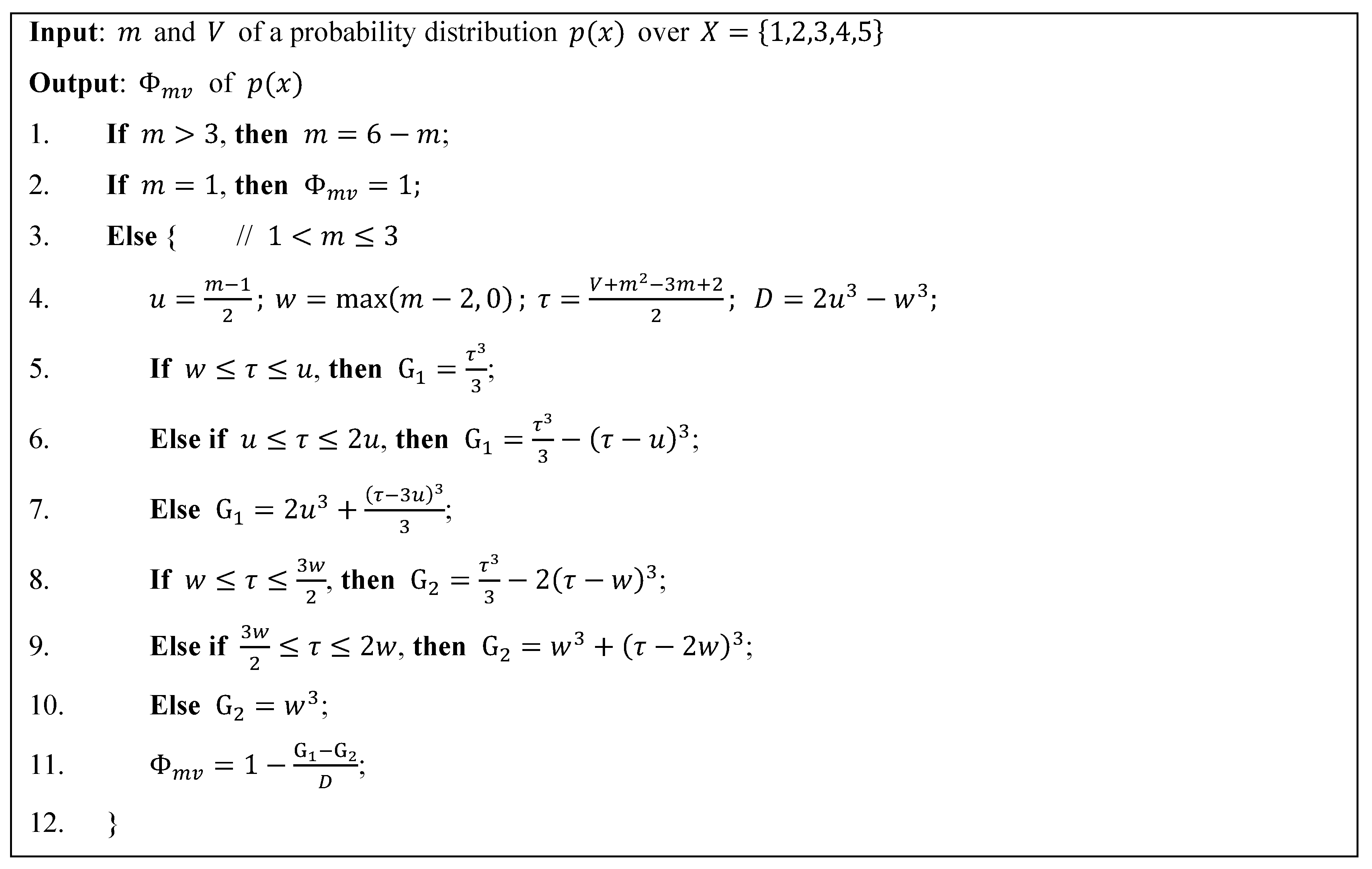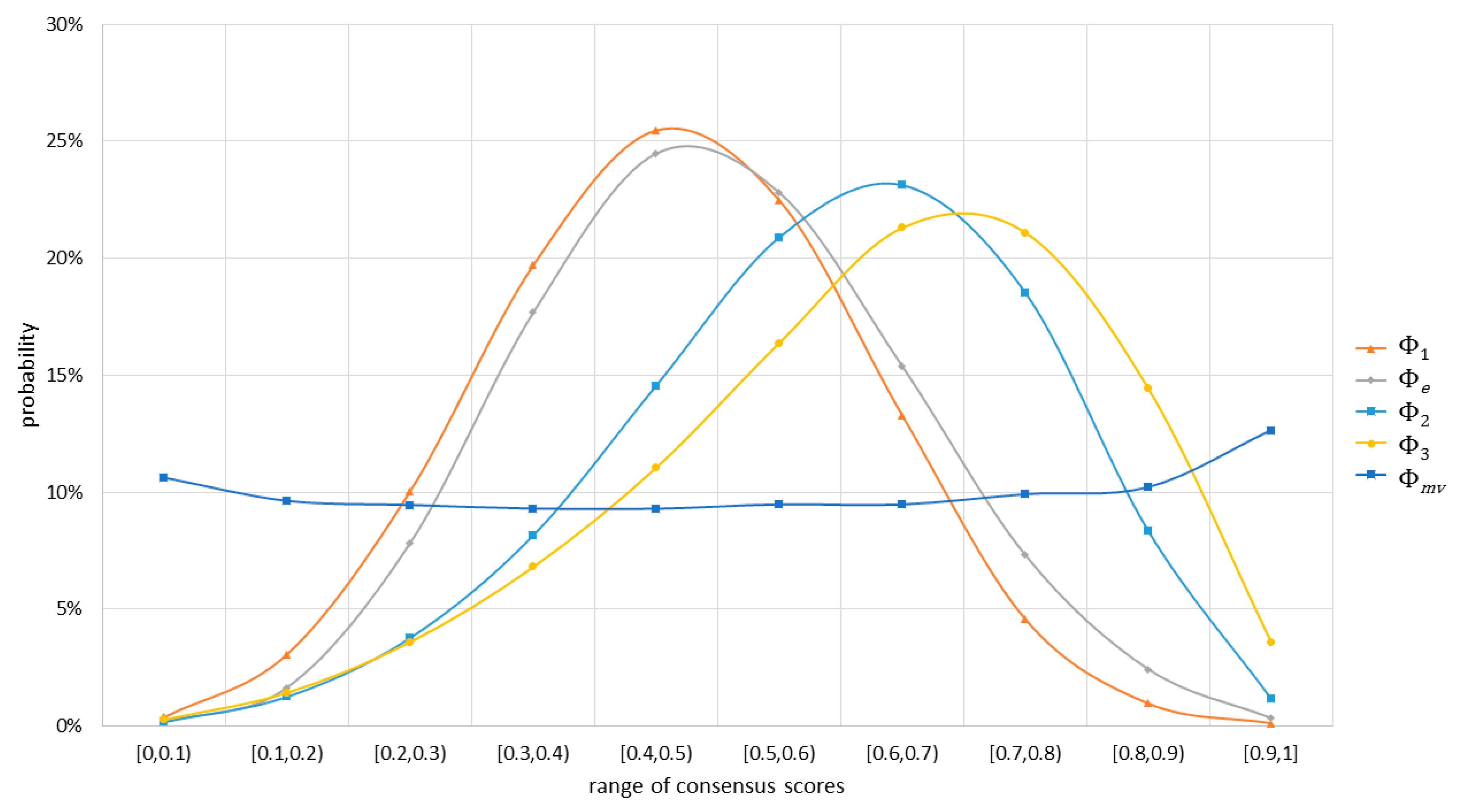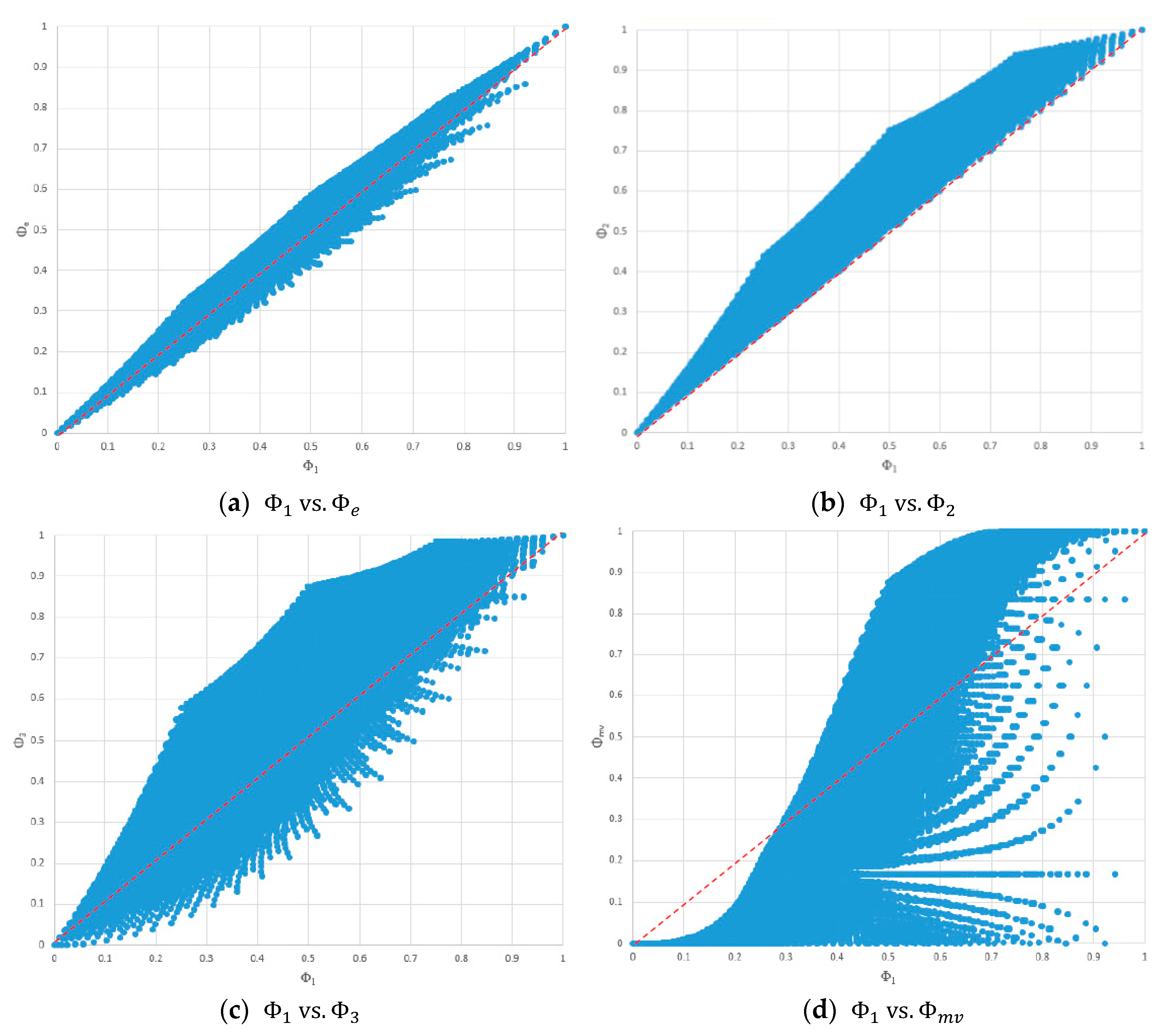3.3. Range of Difference
Although
Table 4 shows that a positive correlation existed between any two consensus measures of the 316,251 generated probability distributions, some of the generated probability distributions did not follow this general trend. In this section, we calculated the range of differences between two consensus measures to show that this difference was usually small, but was sometimes very big.
Table 7 shows the mean differences between any two consensus measures of the 316,251 generated probability distributions. All of the mean differences were small (<0.167), where the largest mean difference occurred between
and
, and the smallest mean difference occurred between
and
. The results were consistent with
Table 4, where the smallest and the largest correlation coefficients were
and
, respectively.
Table 8 shows the maximum difference between any two consensus measures of the 316,251 generated probability distributions. Some of the maximum differences were very large. For example, the maximum difference between
and other consensus measures was larger than 0.84. Notably, all of the correlation coefficients between
and the other consensus measures were greater than 0.92 (see
Table 4), and the mean difference between
and the other consensus measures was less than 0.16 (see
Table 7). Thus, it is reasonable to infer that, although for most probability distributions, the difference between
and the other consensus measures was not large, but for some probability distributions, this difference could be huge. Therefore, it is important to understand for which kinds of probability distributions does such a big difference between various consensus measures occur.
The first four examples in
Table 9 show some of the generated probability distributions where the maximum differences between two consensus measures occurred. Example 1 had a large proportion (98%) of probability at
, thus rendering high consensus scores using
, and
. However, this large proportion of probability at
also made values of
close to 1, where
was the mean of the probability distribution. As discussed in
Section 2.3, the range of variance is small when
approaches either end of the interval [0, 1]. Thus, for values of
close to 1, the range of variance was small, making
very sensitive to even a small proportion of probability at the opposite end of
(2% at
in this example). As a result, Example 1 yielded
. This example was also one of the probability distributions among the 316,251 generated probability distributions that had the maximum difference (in
Table 8) between
and other consensus measures.
Examples 2 and 3 in
Table 9 were similar to Example 1, where a large proportion of probability occurred at
, and a small proportion of probability occurred at
. The values of
remained 0 for Examples 2 and 3. However, the difference between
and
decreased from Example 1 through to Example 3, making
, and
smaller for Examples 2 and 3 than for Example 1. Notably, Example 2 was one of the probability distributions that had the maximum difference (in
Table 8) between
and
; Example 3 was one of the probability distributions that had the maximum difference between
and
.
Example 4 had
, and yielded the maximum difference (in
Table 8) between
and
, between
and
, between
and
, and between
and
. Suppose that the first four examples in
Table 9 describe the voting results at four different stages during a successive voting process. From Example 1 through to Example 4, the value of
decreased, indicating the group’s consensus was diverging. However, using
concluded the opposite. For
,
, and
, the consensus first decreased (from Example 1 through to Example 3), and then increased (from Example 4 onward). However, the differences between the consensus values in Examples 1 and 4 were 0.273596 with
, 0.1716 with
, and −0.02565 with
. Thus, using different consensus measures could lead to different conclusions.
A small change in the probability distribution could result in a different impact on different consensus measures. Consider Examples 1, 7, and 6. They differed by moving a small proportion (2%) of probability from , to , and to , respectively. Although they were similar probability distributions, the value of was 0 in Example 1, and gradually increased to 0.166667 in Example 7, but quickly increased to 0.833333 in Example 6. However, the values of , and did not change much among these three examples. Notably, the proportion of probabilities further from the mean had a greater negative impact on , than on and . Thus, by moving 2% of probability from to (i.e., moving closer to the mean), the ordering of , and changed from in Example 1 to in Example 7. Then, by moving 2% of probability from to , the ordering of , and changed to in Example 6.
The ordering of the values of these consensus measures depended on the probability distribution. For Examples 4, 5, and 6, the value of was the same, but held in Example 4, held in Example 5, and held in Example 6. In Example 7, was the smallest among all consensus measures; however, in Example 8, was the greatest.
3.5. Relationships
To visually inspect the relationships among different consensus measures, we plotted the consensus values of the 316,251 generated probability distributions in two-dimensional (2D) scatter charts.
Figure 3 shows the scatter charts of
scores versus scores based on the other consensus measures, where the red dashed lines represent equality between two consensus scores. As expected, a positively correlated trend existed. No fixed ordering existed between
and the other consensus measures except that
always held, as shown in
Figure 3b. According to
Figure 3a–c, as the value of
approached 0 or 1, the ranges of
and
narrowed, indicating that the maximum differences between
and
, and
decreased. However, when the value of
approached 0.5, the ranges of
, and
increased, indicating that the maximum differences between
and
, and
also increased. Furthermore, the maximum difference between
and
was smaller than both the maximum differences between
and
, and between
and
.
Figure 3d shows that, for
, as the value of
increased, the range of
increased, and the maximum difference between
and
became huge. For any probability distribution satisfying
, its
was also 1. However, for any probability distribution satisfying
, its value of
was not necessarily 1. In fact, there were only
probability distributions satisfying
, that is, when
for some
, and
(this statement also applies to
, and
). However, there were many probability distributions satisfying
(see
Table 2 for examples).
Figure 4 shows the scatter charts of the consensus scores based on
, and
. No fixed ordering existed among these consensus measures except that
always held, as shown in
Figure 4a. According to
Figure 4a,b,d, for
, and
, as the value of one consensus measure approached either end of the interval [0, 1], the range of another consensus measure decreased. According to
Figure 4a,b, the maximum difference between
and
was smaller than that between
and
. According to
Figure 3b and
Figure 4a,d, the maximum difference between
and
was smaller than those between
and
, and between
and
.
Figure 4c,e,f show a similar pattern to
Figure 3d. As the value of
(or
,
) increased (before reaching 1), the range of
increased, and the maximum difference between
(or
and
) and
became huge.









